Page 72 of 600
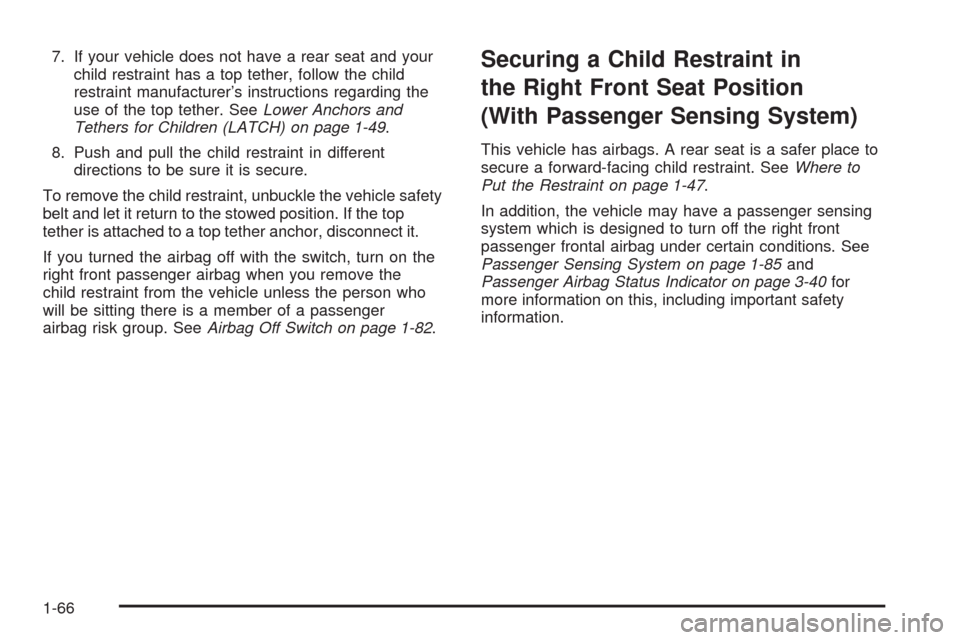
7. If your vehicle does not have a rear seat and your
child restraint has a top tether, follow the child
restraint manufacturer’s instructions regarding the
use of the top tether. SeeLower Anchors and
Tethers for Children (LATCH) on page 1-49.
8. Push and pull the child restraint in different
directions to be sure it is secure.
To remove the child restraint, unbuckle the vehicle safety
belt and let it return to the stowed position. If the top
tether is attached to a top tether anchor, disconnect it.
If you turned the airbag off with the switch, turn on the
right front passenger airbag when you remove the
child restraint from the vehicle unless the person who
will be sitting there is a member of a passenger
airbag risk group. SeeAirbag Off Switch on page 1-82.Securing a Child Restraint in
the Right Front Seat Position
(With Passenger Sensing System)
This vehicle has airbags. A rear seat is a safer place to
secure a forward-facing child restraint. SeeWhere to
Put the Restraint on page 1-47.
In addition, the vehicle may have a passenger sensing
system which is designed to turn off the right front
passenger frontal airbag under certain conditions. See
Passenger Sensing System on page 1-85and
Passenger Airbag Status Indicator on page 3-40for
more information on this, including important safety
information.
1-66
Page 73 of 600
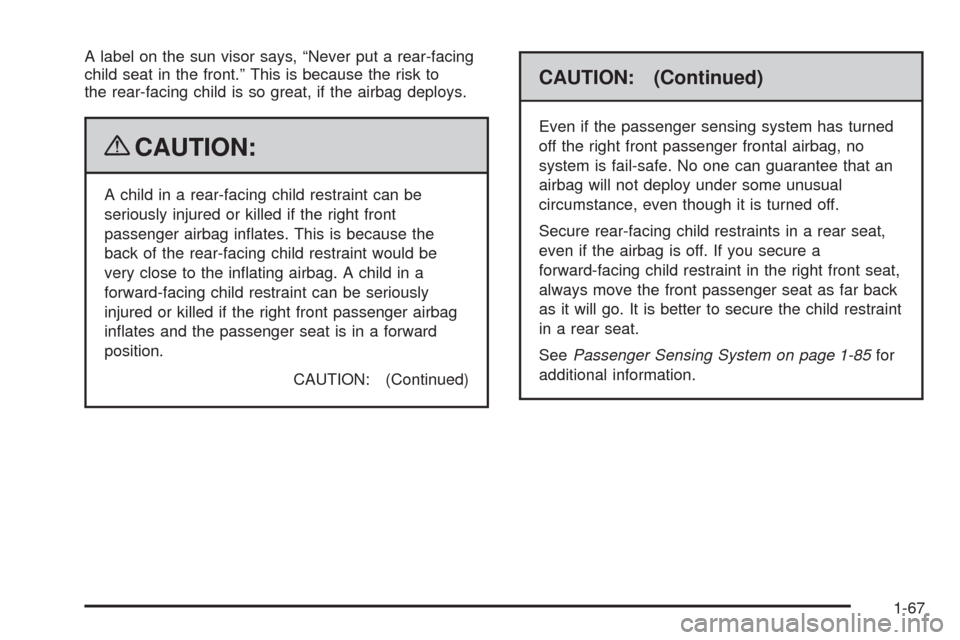
A label on the sun visor says, “Never put a rear-facing
child seat in the front.” This is because the risk to
the rear-facing child is so great, if the airbag deploys.
{CAUTION:
A child in a rear-facing child restraint can be
seriously injured or killed if the right front
passenger airbag in�ates. This is because the
back of the rear-facing child restraint would be
very close to the in�ating airbag. A child in a
forward-facing child restraint can be seriously
injured or killed if the right front passenger airbag
in�ates and the passenger seat is in a forward
position.
CAUTION: (Continued)
CAUTION: (Continued)
Even if the passenger sensing system has turned
off the right front passenger frontal airbag, no
system is fail-safe. No one can guarantee that an
airbag will not deploy under some unusual
circumstance, even though it is turned off.
Secure rear-facing child restraints in a rear seat,
even if the airbag is off. If you secure a
forward-facing child restraint in the right front seat,
always move the front passenger seat as far back
as it will go. It is better to secure the child restraint
in a rear seat.
SeePassenger Sensing System on page 1-85for
additional information.
1-67
Page 74 of 600

If the vehicle does not have a rear seat that will
accommodate a rear-facing child restraint, a rear-facing
child restraint should not be installed in the vehicle,
even if the airbag is off.
If your child restraint has the LATCH system, seeLower
Anchors and Tethers for Children (LATCH) on
page 1-49for how and where to install your child
restraint using LATCH. If you secure a child restraint
using a safety belt and it uses a top tether, seeLower
Anchors and Tethers for Children (LATCH) on
page 1-49for top tether anchor locations.
Do not secure a child seat in a position without a top
tether anchor if a national or local law requires that the
top tether be anchored, or if the instructions that
come with the child restraint say that the top strap must
be anchored.
In Canada, the law requires that forward-facing child
restraints have a top tether, and that the tether be
attached.You will be using the lap-shoulder belt to secure the
child restraint in this position. Follow the instructions that
came with the child restraint.
1. Move the seat as far back as it will go before
securing the forward-facing child restraint.
When the passenger sensing system has turned off
the right front passenger frontal airbag, the off
indicator in the passenger airbag status indicator
should light and stay lit when you start the vehicle.
SeePassenger Airbag Status Indicator on
page 3-40.
2. Put the child restraint on the seat.
3. Pick up the latch plate, and run the lap and shoulder
portions of the vehicle’s safety belt through or
around the restraint. The child restraint instructions
will show you how.
1-68
Page 76 of 600
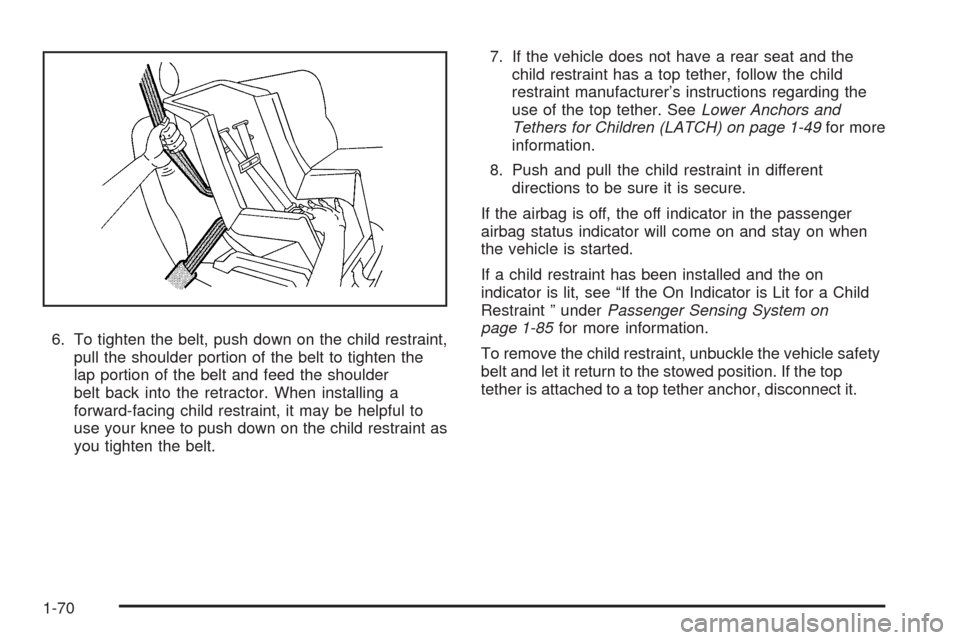
6. To tighten the belt, push down on the child restraint,
pull the shoulder portion of the belt to tighten the
lap portion of the belt and feed the shoulder
belt back into the retractor. When installing a
forward-facing child restraint, it may be helpful to
use your knee to push down on the child restraint as
you tighten the belt.7. If the vehicle does not have a rear seat and the
child restraint has a top tether, follow the child
restraint manufacturer’s instructions regarding the
use of the top tether. SeeLower Anchors and
Tethers for Children (LATCH) on page 1-49for more
information.
8. Push and pull the child restraint in different
directions to be sure it is secure.
If the airbag is off, the off indicator in the passenger
airbag status indicator will come on and stay on when
the vehicle is started.
If a child restraint has been installed and the on
indicator is lit, see “If the On Indicator is Lit for a Child
Restraint ” underPassenger Sensing System on
page 1-85for more information.
To remove the child restraint, unbuckle the vehicle safety
belt and let it return to the stowed position. If the top
tether is attached to a top tether anchor, disconnect it.
1-70
Page 77 of 600
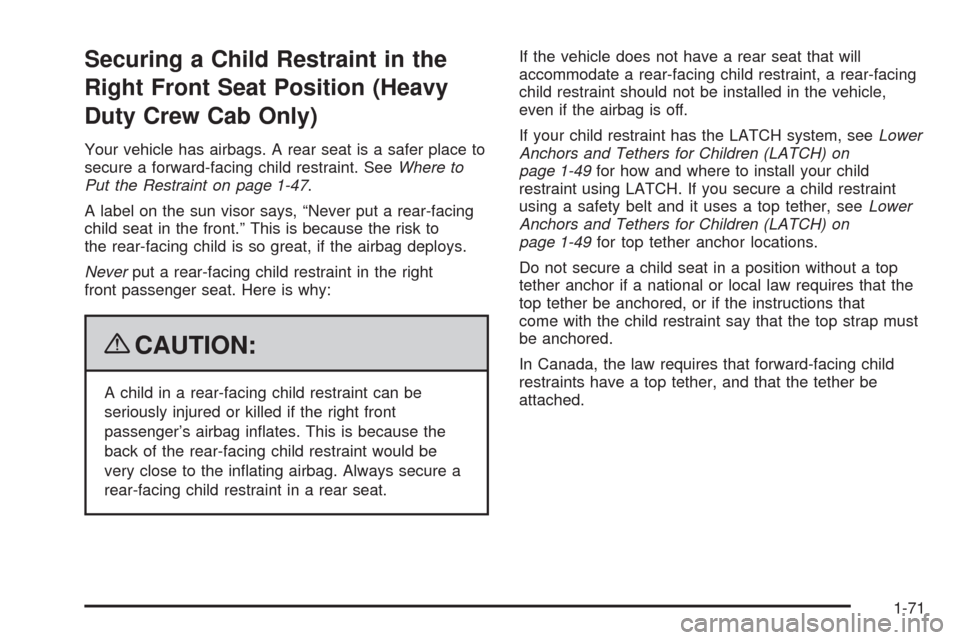
Securing a Child Restraint in the
Right Front Seat Position (Heavy
Duty Crew Cab Only)
Your vehicle has airbags. A rear seat is a safer place to
secure a forward-facing child restraint. SeeWhere to
Put the Restraint on page 1-47.
A label on the sun visor says, “Never put a rear-facing
child seat in the front.” This is because the risk to
the rear-facing child is so great, if the airbag deploys.
Neverput a rear-facing child restraint in the right
front passenger seat. Here is why:
{CAUTION:
A child in a rear-facing child restraint can be
seriously injured or killed if the right front
passenger’s airbag in�ates. This is because the
back of the rear-facing child restraint would be
very close to the in�ating airbag. Always secure a
rear-facing child restraint in a rear seat.If the vehicle does not have a rear seat that will
accommodate a rear-facing child restraint, a rear-facing
child restraint should not be installed in the vehicle,
even if the airbag is off.
If your child restraint has the LATCH system, seeLower
Anchors and Tethers for Children (LATCH) on
page 1-49for how and where to install your child
restraint using LATCH. If you secure a child restraint
using a safety belt and it uses a top tether, seeLower
Anchors and Tethers for Children (LATCH) on
page 1-49for top tether anchor locations.
Do not secure a child seat in a position without a top
tether anchor if a national or local law requires that the
top tether be anchored, or if the instructions that
come with the child restraint say that the top strap must
be anchored.
In Canada, the law requires that forward-facing child
restraints have a top tether, and that the tether be
attached.
1-71
Page 78 of 600
You will be using the lap-shoulder belt to secure the
child restraint in this position. Follow the instructions that
came with the child restraint.
1. Move the seat as far back as it will go before
securing the forward-facing child restraint.
2. Put the child restraint on the seat.
3. Pick up the latch plate, and run the lap and shoulder
portions of the vehicle’s safety belt through or
around the restraint. The child restraint instructions
will show you how.
4. Push the latch plate into the buckle until it clicks.Make sure the release button is positioned so you
would be able to unbuckle the safety belt quickly
if necessary.
5. Pull the rest of the shoulder belt all the way out of
the retractor to set the lock.
1-72
Page 79 of 600
6. To tighten the belt, push down on the child restraint,
pull the shoulder portion of the belt to tighten the
lap portion of the belt and feed the shoulder
belt back into the retractor. If you are using a
forward-facing child restraint, you may �nd it helpful
to use your knee to push down on the child
restraint as you tighten the belt.7. If your child restraint has a top tether, follow the
child restraint manufacturer’s instructions regarding
the use of the top tether. SeeLower Anchors
and Tethers for Children (LATCH) on page 1-49for
more information.
8. Push and pull the child restraint in different
directions to be sure it is secure.
To remove the child restraint, unbuckle the vehicle safety
belt and let it return to the stowed position. If the top
tether is attached to a top tether anchor, disconnect it.
1-73
Page 81 of 600
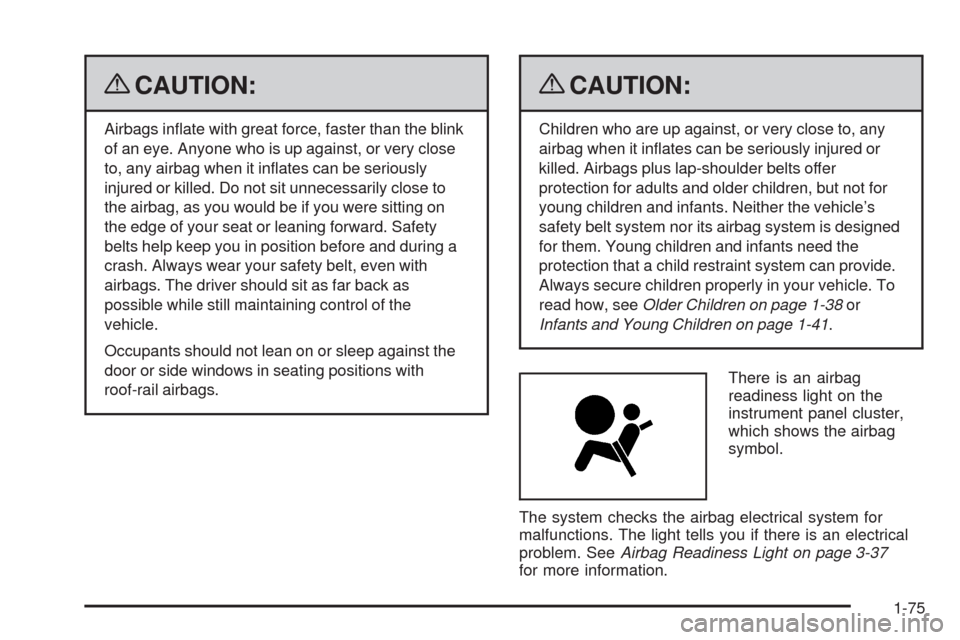
{CAUTION:
Airbags in�ate with great force, faster than the blink
of an eye. Anyone who is up against, or very close
to, any airbag when it in�ates can be seriously
injured or killed. Do not sit unnecessarily close to
the airbag, as you would be if you were sitting on
the edge of your seat or leaning forward. Safety
belts help keep you in position before and during a
crash. Always wear your safety belt, even with
airbags. The driver should sit as far back as
possible while still maintaining control of the
vehicle.
Occupants should not lean on or sleep against the
door or side windows in seating positions with
roof-rail airbags.
{CAUTION:
Children who are up against, or very close to, any
airbag when it in�ates can be seriously injured or
killed. Airbags plus lap-shoulder belts offer
protection for adults and older children, but not for
young children and infants. Neither the vehicle’s
safety belt system nor its airbag system is designed
for them. Young children and infants need the
protection that a child restraint system can provide.
Always secure children properly in your vehicle. To
read how, seeOlder Children on page 1-38or
Infants and Young Children on page 1-41.
There is an airbag
readiness light on the
instrument panel cluster,
which shows the airbag
symbol.
The system checks the airbag electrical system for
malfunctions. The light tells you if there is an electrical
problem. SeeAirbag Readiness Light on page 3-37
for more information.
1-75